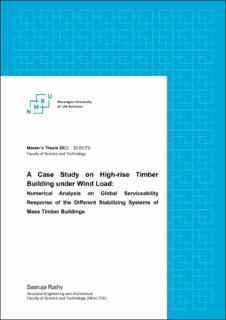| dc.description.abstract | Summary
Reducing greenhouse gas emissions is crucial in the construction industry, as it is responsible for significant emissions. Building projects alone contribute to 33% of CO2 emissions, while transportation and material production account for up to 82-96% of total emissions. Timber, a sustainable and lightweight material, positively impacts the environment when used in construction. There is a growing trend towards incorporating more timber in building construction globally, particularly in constructing tall timber buildings to reduce emissions. However, concerns have been raised about the comfort of occupants in these structures due to the lightweight nature of timber, which causes the highest oscillation to occur at the top of the building.
Different structural systems like frames, shear walls, and diagrid systems are developed and evaluated for their capacity to endure wind loads within all-timber systems to examine oscillation at the highest point of a building. The goal is to identify the most productive and efficient approaches to withstand wind loads by analyzing deflection, inter-story drift, and peak acceleration.
Based on the ISO 10137 comfort level, numerical models were created, observed, and evaluated. The results indicated that the diagrid system surpassed both the frame and shear wall systems due to its ability to withstand lateral forces with a higher natural frequency and lower peak acceleration despite being lighter in weight. The diagrid system demonstrated exceptional performance during the analysis despite its low mass.
When analyzing the natural frequencies and peak accelerations of all systems, it was apparent that the diagrid system had substantially higher natural frequencies than the frame and shear wall systems. Moreover, the diagrid system’s peak acceleration was lower than the frame and shear wall systems. These findings conclude that a diagrid system is a superior option compared to the current frame and shear wall systems.
One essential aspect to consider is the deflection of each system, which is influenced by the structure’s stiffness. The diagrid system deflected only 13.24 mm, less than the frame and shear wall system. Regarding practical applications, engineers and architects now have an alternative option in the diagrid system for controlling overall timber building vibrational serviceability, especially during wind activities. | |
